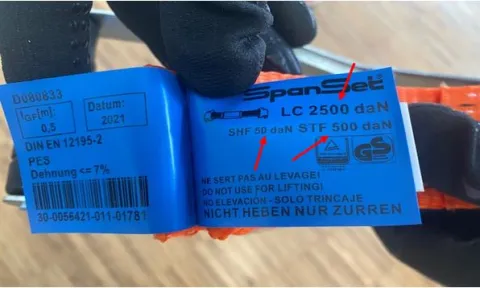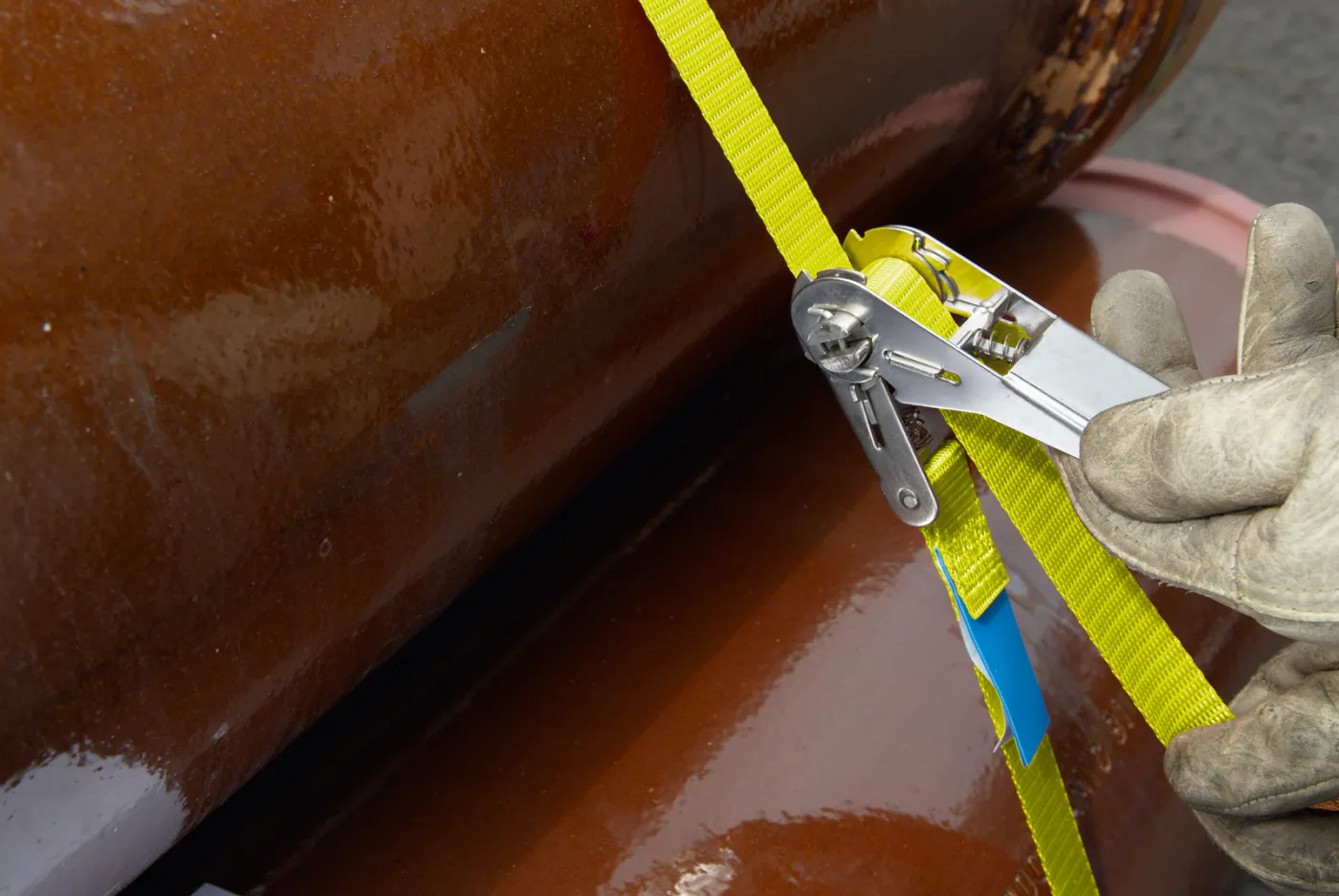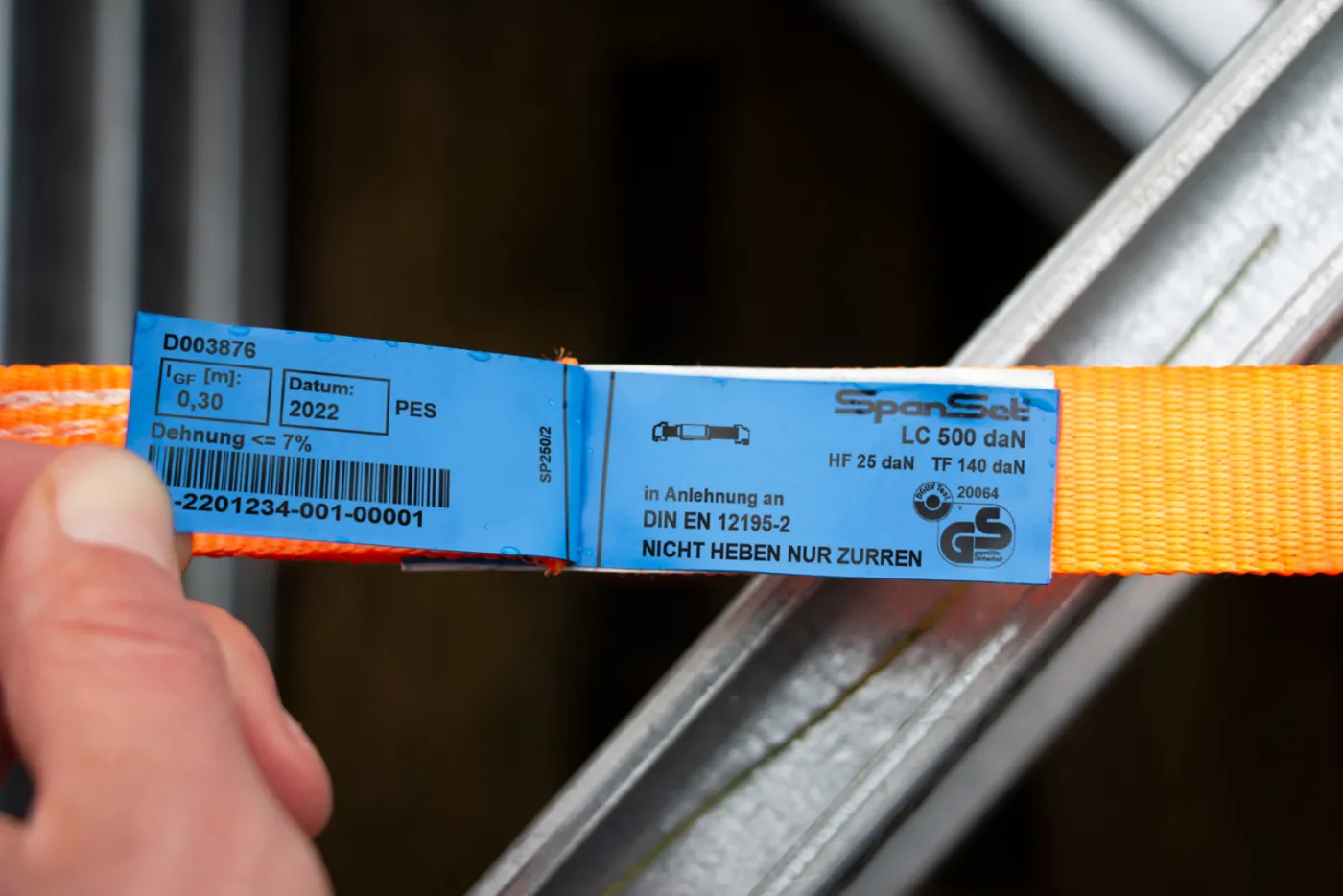Load control: What does “conforming to the norm” mean?
Considering a dilemma when labelling lashing systems
Are we allowed to use products labelled with the GS approval mark, which at the same time show the notice “conforming to the norm” as if they were properly approved safe-to-use products or tools respectively? The answer is: Yes! However, the notice “conforming to the norm” causes a feeling of unease. Now is the time to provide information about its background, to interpret the present norm and to adjust it as soon as possible. This concerns norm EN 12195-2.
Safety requirements related to lashing systems for load security basically result from EN 12195-2. This norm stipulates that the Standard Tension Force (STF) of a lashing system is determined using a common Standard Hand Force (SHF) of 50 daN.
Topic load security
Being more specific, this means: for example, for a lashing system with a nominal width of 50 mm a Standard Tension Force of 500 daN is generated using a Standard Hand Force of 50daN. Both, Standard Hand Force and Standard Tension Force are shown on the label (see Ill. 1). This alone does not say, the product is according to norm, as the Standard Tension Force is determined by upper and lower limits. The norm stipulates that the Standard Tension Force generated with the above-mentioned Standard Hand Force should achieve a minimum of 10% of the maximum Lashing Capacity (LC) and can go to a maximum of 50 %.

Ill. 1: Showing the STF (Standard Tension Force) and LC (Lashing Capacity) on the label of a lashing system certified by TÜV Rheinland.
Straps from all manufacturers with a nominal width of 50 (and also 35) mm have to meet with this specification. The Standard Tension Force generated using a Standard Hand Force of 50 daN is in most cases between 250 and 500 daN for systems with a lashing capacity of 2,500 daN. In our example (Ill. 1) the above-mentioned values are at 50 daN and 2,500 daN respectively. That means: The Standard Tension Force is above 10 and achieves the maximum allowable value of 50 percent system resilience of 2,500 daN. The product is in line with the norm and GS certifiable with regard to the Standard Tension Force.
With regard to the light-weight lashing systems with a width of only 25 mm the manufacturers and users find themselves in a dilemma regarding EN 12195-2
When looking at various nominal widths of lashing systems (25, 35, 50, 75 mm) the EN 12195-2 does not differentiate with regard to the Standard Hand Force of 50 daN. It stands to reason, however, and has been sufficiently proven in practical tests, that applying a Standard Hand Force of 50 daN to the narrow 25 mm ratchet (“mini ratchet”) is impossible for ergonomic reasons (Ill. 2). As a rule, its handles cannot be covered by the whole hand. That is why after a sequence of tests, applying a Standard Hand Force of 25 daN has proven appropriate and acceptable. But the norm does not allow for this, the application described here was not sufficiently considered at the time when the norm was developed.

Ill. 2: Using a mini ratchet for lashing down.
This lack of differentiation with regard to the Standard Hand Force for different nominal widths of lashing systems or for different size ratchets respectively, is not a safety-related issue. But it indicates an issue when applying the norm. This is where a revision has long been overdue.Die fehlende Differenzierung der Handkräfte für die unterschiedlichen Nennbreiten von Zurrsystemen beziehungsweise für unterschiedliche Größen von Ratschen stellt kein sicherheitstechnisches Problem dar. Aber sie birgt Schwierigkeiten bei der Anwendung der Norm. An dieser Stelle besteht seit längerem Änderungsbedarf.
ZLS: Determining Standard Tension Force for narrow lashing straps using 25daN rather than 50daN
The Central State Authority for Safety Technology (Zentralstelle der Länder für Sicherheitstechnik, ZLS) reacted a long time ago. Regarding testing and certification processes for the (voluntary) attainment of the GS symbol, the relevant ZLS body for the exchange of experience for test centres after intensive consultations determined some time ago that the Standard Tension Force for lashing straps with a width of 25 mm should be determined using a Standard Hand Force of 25 daN. And not with 50 daN as stipulated in the norm focusing on lashing straps with a width of 50 mm. This process is to be applied as standard by all test centres which offer GS testing and certification of lashing straps.
Markus Jakobi: “A frequently applied process is aimed at correcting deficiencies in norms”
This might surprise the reader at first sight. But according to Markus Jakobi, DGUV Test, this is a “frequently applied process by GS test centres to correct deficiencies and gaps in norms or which have experienced technical developments and have so far not been determined by norms regarding safety-related assessment.” After all, these are measures that can bridge the time gap concerning the required adjustment of the norm. "Norms are checked every 5 years to see if revisions are required. If, however, there is not a sufficient majority in the relevant European standardisation committee or revision is not urgently required, the validity of the norm in question will be confirmed for another 5 years as a rule.
How this is handled in every day action is shown in example 2 (Ill. 3): In this case a Standard Tension Force of 140 daN can be achieved applying a Standard Hand Force of 25 daN. Markus Jakobi: “The product meets the essential requirement: For a Hand Tension Force of 25daN determined by the agreed testing principle of GS test centres, the achieved Standard Tension Force is below 50% of the maximum lashing capacity, as is stipulated by the norm. The product can therefore be issued with the GS symbol and can be used for lashing down purposes. But for formal reasons the notice: “Conforming to the norm” is required.

Ill. 3: Certification of a light lashing system by DGUV “following” norm EN 12195-2.
Why conforming to? Because the applicable EN 12195-2 normatively stipulates that – contrary to the ZLS-decision – the lashing capacity was determined using a Standard Hand Force of 50daN.
What does that mean for our example?
The currently applied standard procedure is that the labels of light lashing systems do not indicate any Standard Hand Force to avoid the 25-50-daN dilemma. But beware! If the label does not indicate a Standard Hand Force, according to the norm that system has not been approved for lashing down purposes. If the straps are meant for lashing down, the indication “conforming to the norm” is mandatory.
And this results in irritation
Buyers, applicants and authorised testers are as a rule satisfied with that in most cases. But not everybody! Though the GS symbol is a signal for the user that the safety of the product has been certified, the notice “conforming to the norm” creates confusion and may even result in rejecting the product. This is at the same time understandable and regrettable, but also unnecessary.
Demands resulting from this
In order for light lashing systems, which have been approved for the use in road transport, not needing to be marked with the irritating “conforming to ...” notice and are entitled to be issued with a GS symbol, the norm EN 12915-2 should be revised. We need a norm that considers the Standard Hand Force of the lashing straps with a differentiated approach according to their design and that stipulates a value of 25 daN for testing the decidedly ergonomic and narrow straps. This would turn a product which at present is only supplied “conforming to the norm” into a product with a GS symbol without product-related technical changes, using an administrative approach. This is the common aim of all manufacturers, users and testers.
Legend
| Zurrkraft | Lashing Capacity | LC | Maximum force that is admittable for application on the lashing system (lashing strap capacity) |
| Vorspannkraft | Standard Tension Force | STF | The force that is generated by the Standard Hand Force and is affective on the lashing system |
| Handkraft | Standard Hand Force | SHF | The force the user applies for tensioning the ratchet |